How To Create a Construction Progress Report
-
Sapna
- May 13, 2024
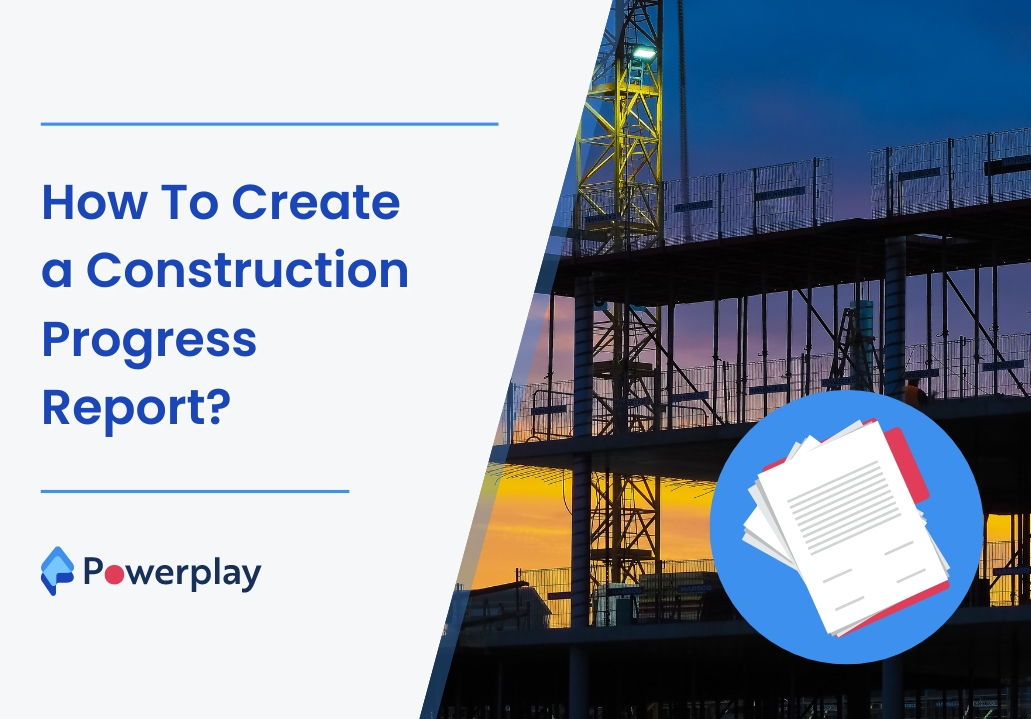
In the construction industry, the term “work in progress” signifies ongoing projects that are not yet complete. Understanding the status of such projects through a construction progress report is crucial for companies to manage current activities and plan future expenditures effectively. Whether in business, accounting, or construction, grasping the essentials of work in progress reporting can empower you to make informed decisions about current and future projects.
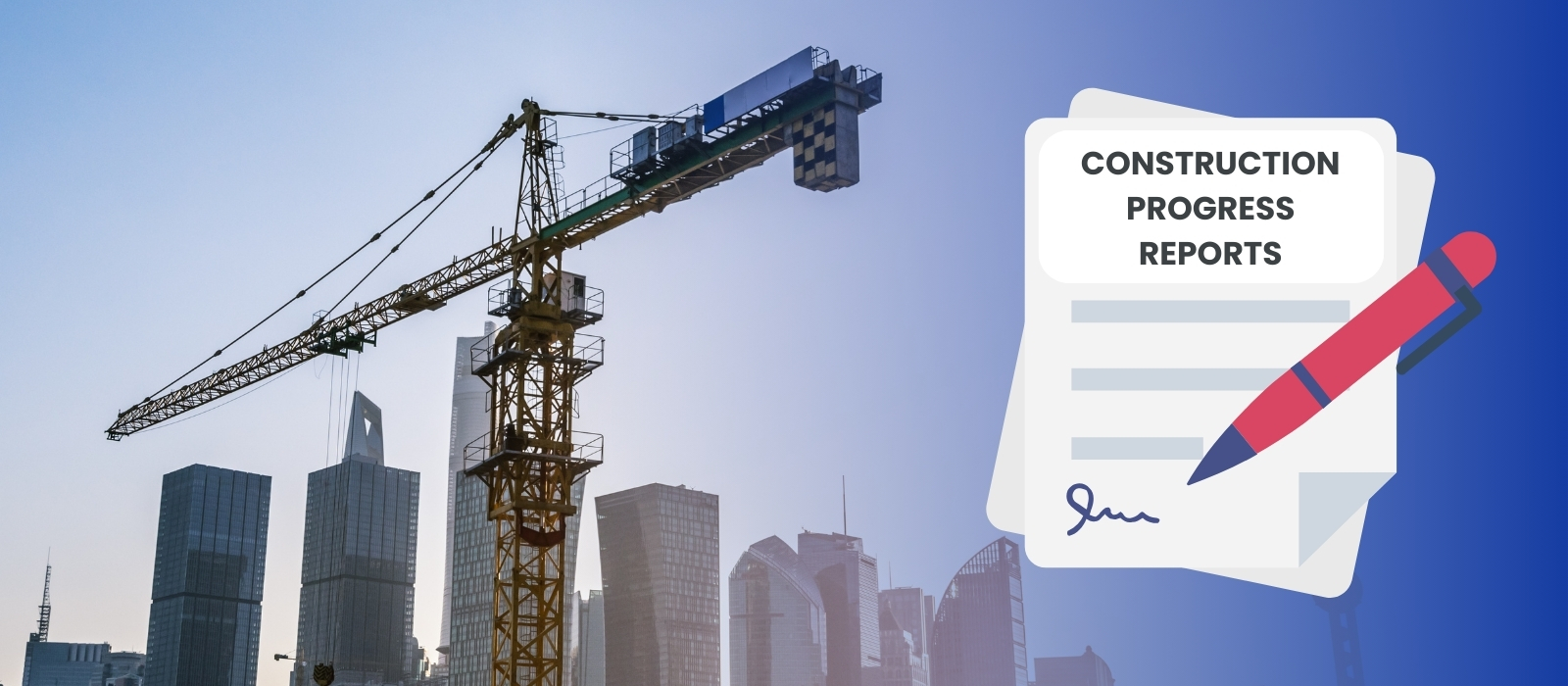
In this blog, we’ll explore construction progress report, the importance of WIP reports, and a step-by-step method for creating a work in progress report. We will also learn how Powerplay can help create the construction progress report.
Table of Contents
What Is a Construction Progress Report?
A construction progress report is a detailed document crucial for construction project management, summarising a construction project’s current status. It includes information about the construction project progress, such as the work completed, the timeline of activities, any issues or delays encountered, and financial expenditures.
This report is essential for keeping stakeholders, such as project managers, clients, and investors, informed about the progress and any potential risks. It typically covers completion percentage, labour and material usage, compliance with safety regulations, and critical milestone updates related to project tracking and reporting. The report aids decision-making, ensuring the project remains on track and within budget.
What is the purpose of a Progress Report in Construction?
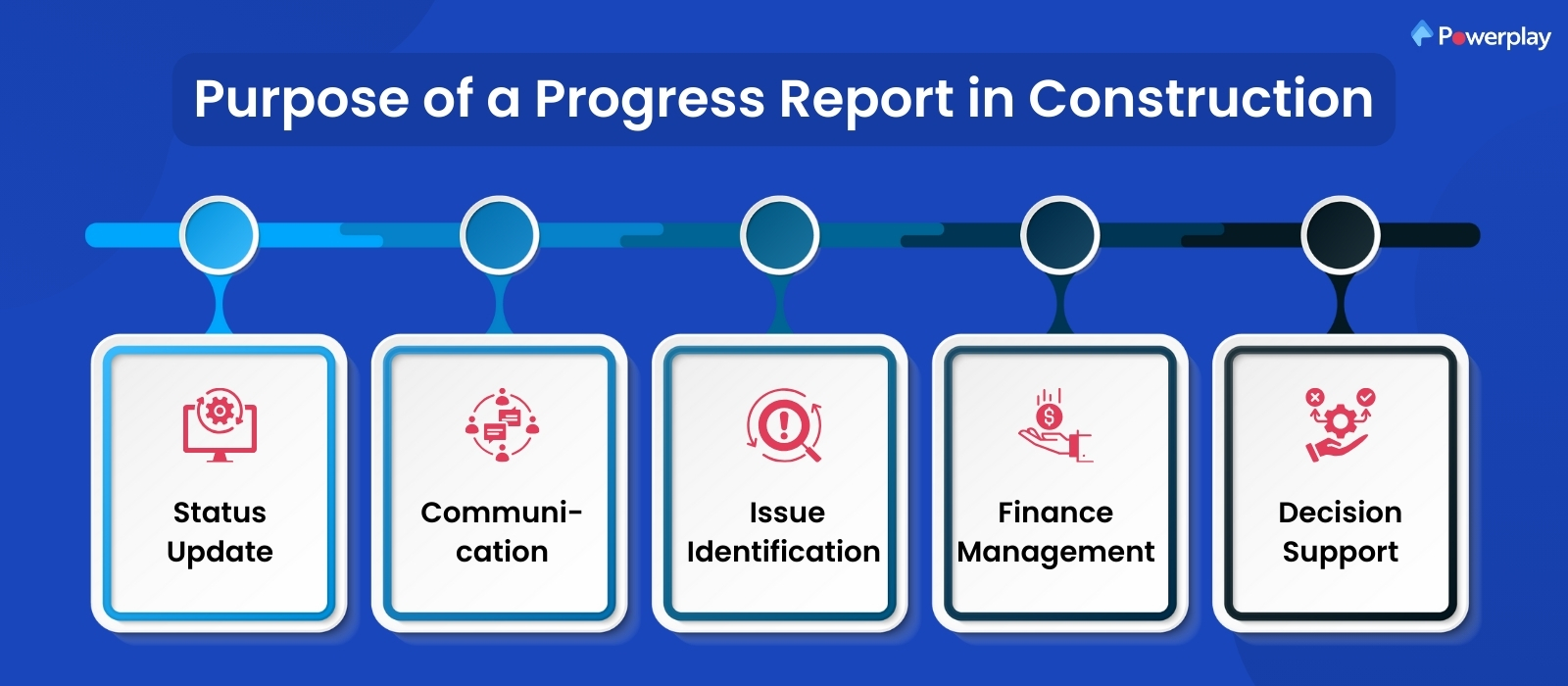
A progress report on construction provides a comprehensive overview of the project’s current status, ensuring that all stakeholders are aware about progress, challenges, and financial health. It monitors and documents progress against planned schedules, facilitating effective communication among project managers, clients, and contractors.
The report allows for timely interventions and corrective actions by identifying issues or delays early. Additionally, it aids in financial management by tracking expenditures and resource use, ensuring the project stays within budget. The progress report supports decision-making and maintains accountability throughout the construction process.
Why are construction progress reports important?
Construction progress reports are crucial because they provide transparency and accountability throughout construction. They inform stakeholders about the project’s status, ensuring work is aligned with schedules and budgets. These reports help promptly identify and address issues or delays, preventing costly overruns and providing efficient resource utilisation. Incorporating progress tracking into these reports enhances construction project management by allowing for the tracking of completion percentages of different activities, monitoring the progress of each activity, and connecting progress tracking with project management tools for efficient reporting.
Progress reports also facilitate clear communication among all parties involved, fostering collaboration and informed decision-making. The integration of project reporting software further benefits this process by collecting and displaying project data, generating different types of reports, sharing project status updates with stakeholders, and simplifying the reporting process. This software enables the monitoring and tracking of project metrics in real time and creates project status reports to keep stakeholders informed of project progress. Moreover, they serve as a historical record, useful for future and to demonstrating compliance with regulatory and safety standards. Overall, they are essential for successful project management and completion.
Key Components of a Construction Progress Report

Key components of a construction progress report typically include:
- Project Summary: A brief overview highlighting the key developments and general status of the project.
- Progress Analysis: Details on how the project meets the planned schedule, including any delays and their reasons.
- Commercial and Contractual Updates: Information on commercial interests and contractual agreements relevant to the project, such as contract changes and financial standings.
- Photos and Visuals: Progress pictures and, if possible, drone shots to give a visual insight into the work done.
- Quality and Safety: Notes on any quality concerns and health and safety issues experienced during the period.
- Weather Reports: Information on how the weather has affected the work.
- Neighbour Relations: Discussion of any issues faced by neighbours, like noise complaints or safety concerns.
How to Create a Construction Progress Report
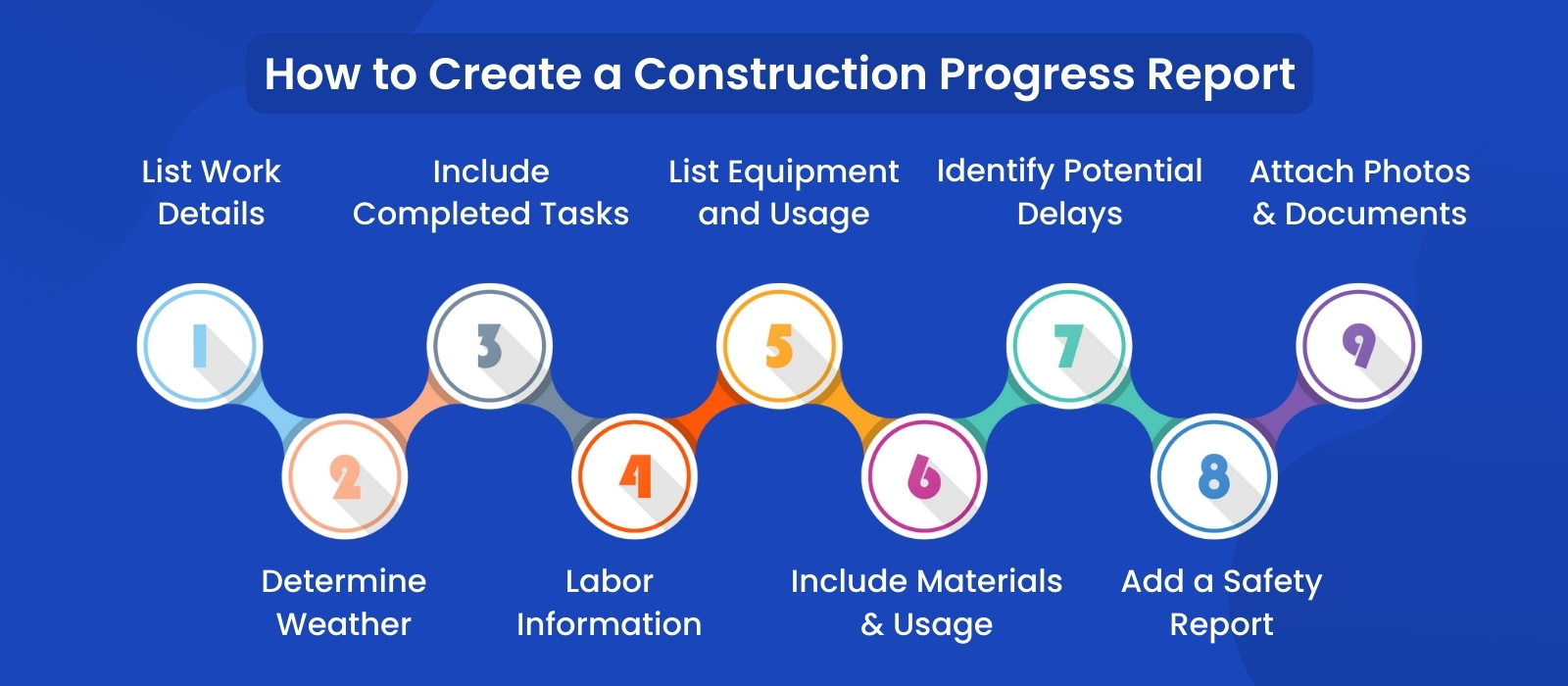
Creating a comprehensive construction progress report is essential for documenting the project status of a construction project, communicating with stakeholders, and ensuring the project remains on track. This report plays a crucial role in project communication, reporting, and management, acting as a project status report that keeps stakeholders informed of progress while monitoring costs, risks, time, and work. Below is a detailed explanation of each element that should be included in such a report, emphasising the importance of including a project status report to provide historical data for future projects and to maintain transparency with all project stakeholders.
List Work Details:
This section should provide a clear overview of the work that has been done during the reporting period. Include specific tasks, the location within the project site, and any significant milestones achieved. This helps stakeholders understand the scope of work covered and the progress made.
Determine Weather:
Document the weather conditions during the reporting period, as they can significantly impact construction activities. Include information like temperature, precipitation, and any weather-related delays or incidents. This helps in understanding external factors affecting the project’s progress.
Include Completed Tasks:
Create detailed information about the tasks that have been fully completed during the period. This should include the start and end dates for each task, the work done, and how it aligns with the project timeline. Highlighting completed tasks provides a sense of accomplishment and helps track overall progress.
Labour Information
Document the total hours worked and list the employees or contractors who were involved, ensuring the workload is balanced across the entire team. Include their roles and the specific tasks they worked on, and keep track of the number of tasks assigned to each team member. This approach is crucial for labour cost tracking, assessing workforce productivity, and enhancing team morale by effectively balancing the workload.
List Equipment and Usage:
Record all the equipment used during the reporting period, including machinery like cranes, bulldozers, or specialised tools. Note the usage hours and any maintenance or repair issues. This helps manage equipment efficiently and plan for future needs.
Include Materials and Usage:
Detail the materials used during the period, including quantities, types (like concrete, steel, etc.), and the specific project parts used. This aids in tracking material costs and inventory, ensuring there are no delays due to material shortages.
Identify Potential Delays:
Proactively identify potential project delays, whether due to supply chain issues, labour shortages, regulatory approvals, or other factors. Suggest possible solutions or adjustments to mitigate these delays. This proactive approach helps maintain the project timeline.
Add a Safety Report:
Include a section on safety detailing any incidents, near misses, or hazards identified during the period. Outline the measures to address these issues and ensure a safe working environment. This is vital for compliance and fostering a safety culture on the site.
Attach Photos and Relevant Documents:
Visual documentation can significantly enhance the effectiveness of a progress report. Include photos of the construction site showing completed work and any areas of concern. Relevant documents like architectural drawings, permits, and inspection reports should also be attached to provide a comprehensive view of the project’s status. Incorporating these elements not only enriches the content but also streamlines the reporting process, enhancing the professionalism and comprehensiveness of construction progress reports.
Construction Progress Report Template
A Construction Progress Report Template is a critical document that summarizes the current status of a construction project. It typically includes updates on completed activities, any issues or delays, and the next steps or planned activities. This report helps stakeholders stay informed and ensures that the project remains on track.
How Powerplay can help in the Construction Progress Report
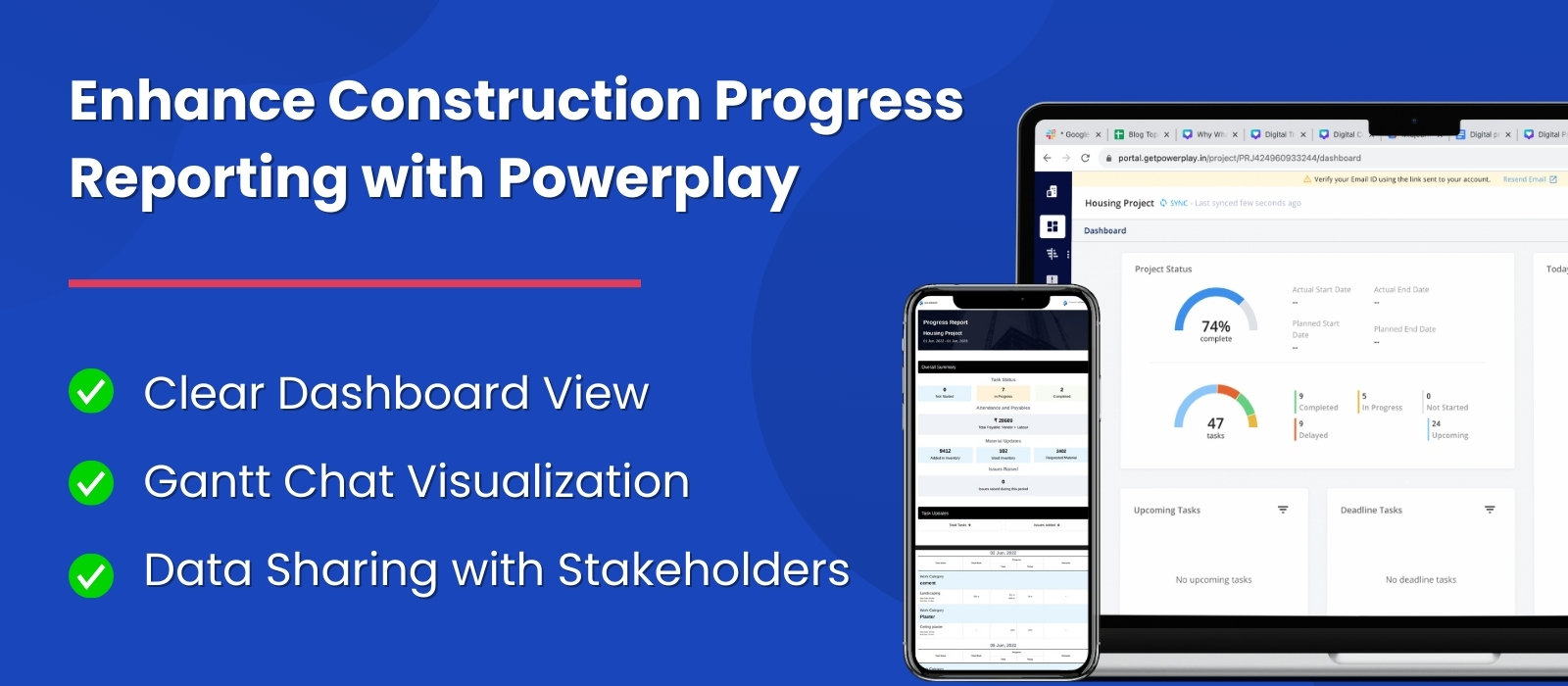
Powerplay can significantly enhance the process of generating and managing Construction Progress Reports, including the creation and management of detailed status reports for construction projects, by offering a suite of features such as:
- Clear Dashboard View: Powerplay provides a comprehensive dashboard with a detailed overview of the project’s progress. This includes metrics on tasks completed, resources used, timelines, and the ability to generate status reports at different frequencies—daily, weekly, monthly, and quarterly. The dashboard is user-friendly and helps in making informed decisions quickly, making it an essential tool for monitoring costs, risks, time, and work.
- Gantt Chat Visualisation: Powerplay offers a dynamic visualisation of the construction progress, enabling users to see real-time updates and changes in a visual format. This makes it easier to understand the project’s status at a glance, spot any issues or delays, and effectively communicate these in a status report.
- Data Sharing with Stakeholders: The platform allows for seamless sharing of progress reports, including status reports, with various stakeholders, including team members, clients, and suppliers. This ensures everyone is informed and can contribute or adjust plans as needed, enhancing the overall management of the project.
How to Create Site Photo Reports in Minutes
With the Powerplay app, creating Site Photo Reports is quick and efficient. Users can easily capture photos directly from the construction site using their mobile devices. The app allows for immediate tagging and annotation of images with relevant details such as location, time, and comments. These photos can then be uploaded in real-time, ensuring that they are integrated into the project’s documentation. This streamlined process allows for instant sharing with team members and stakeholders, facilitating rapid communication and decision-making.
Conclusion
Creating a comprehensive Construction Work in Progress Report is essential for effective project management as these reports provide a clear, detailed view of the project’s status, helping stakeholders stay informed about progress, challenges, and financial aspects.
Adopting construction software’s like Powerplay enhances this process by offering real-time data collection, visual dashboards, and seamless communication features. By integrating Powerplay into the reporting workflow, construction teams can ensure accuracy, efficiency, and proactive problem-solving, leading to smoother project execution and to make informed decisions, ultimately contributing to the successful completion of construction projects so download the Powerplay app now and start building your dream project.













